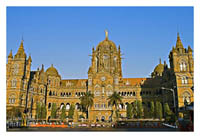 Experience the highlights of this fascinating city, with its Western monuments and Eastern sensibilities. Begin with a visit to Mani Bhavan, Gandhi’s Bombay base between 1917 and 1934. It is now a permanent museum and memorial to the Mahatma, and contains a research library of more than 20,000 volumes. A series of tiny dioramas tell his life story in an interesting fashion. The walls are covered with photos of historic events and noteworthy people and there are a number of personal artefacts – including a letter to Hitler asking him not to go to war, and correspondence with Roosevelt, Tolstoy, and Einstein. Gandhi’s sitting room/bedroom is preserved behind Experience the highlights of this fascinating city, with its Western monuments and Eastern sensibilities. Begin with a visit to Mani Bhavan, Gandhi’s Bombay base between 1917 and 1934. It is now a permanent museum and memorial to the Mahatma, and contains a research library of more than 20,000 volumes. A series of tiny dioramas tell his life story in an interesting fashion. The walls are covered with photos of historic events and noteworthy people and there are a number of personal artefacts – including a letter to Hitler asking him not to go to war, and correspondence with Roosevelt, Tolstoy, and Einstein. Gandhi’s sitting room/bedroom is preserved behind
Continue to the Church Gate Station, where you will board a local train to experience the life of a typical Mumbaikar! You take a short ride to Mahalaxmi Station another one of Mumbai’s busiest hub on the local train
Even if you are not possessed of an interest in other people’s dirty laundry, you’ll be fascinated by the dhobi ghats, your next stop. Each morning washing from all over Mumbai is brought here to be soaped, soaked, boiled, beaten, and thrashed. The next day, after being aired, pressed, folded and wrapped, the bundles are returned from whence they came. The secret that keeps the operation running smoothly is the coded symbol that each dhobi-wallah places on every item. Invisible to the untrained eye, this mark ensures that nothing will be lost. Stop here for photos that you’ll never be able to duplicate anywhere else.
Your next visit will be to the historic Shri Siddhivinayak Temple, dedicated to Lord Ganesh, the elephant-headed god. Inside is a figure of Ganesh, visible from any point within the temple. Surprisingly his trunk turns towards the right unlike most other depictions where it points left. Plump little Ganesh, with a twinkle in his eye, is one of Hinduism’s most popular gods. Revered as the remover of obstacles, his name is invoked before every undertaking. His image is often placed above gateways, and in shops and houses, where he sits on a throne or lotus holding a variety of objects in his four hands – one of which is always a bowl of sweets. All the major Hindu deities have “vehicles” that attend them, and carry them about. Somehow it seems apt that Ganesh’s vehicle is a mouse.
An Indian lunch awaits you at a local restaurant!
After lunch, spend some time watching the dabba-wallahs, the members of the Mumbai Tiffin Box Suppliers Association. Every day 4,000 of them deliver fresh, home-cooked food from 100,000 suburban kitchens to offices in the downtown area. Each lunch is prepared by a loving wife or mother, and packed into a set of stackable aluminium boxes. The meals are carried to their hungry recipients dangling from shoulder-poles and bicycle handlebars, and stacked on decorated handcarts. Tins are rarely, if ever, lost, and always find their way home again to be washed up for the next day lunch.
Before you return to the pier, a brief photo stop will be made at the Gateway of India, the city’s most famous landmark – an Indo-Saracenic archway built in 1911 to commemorate the visit of King George V and Queen Mary. It was originally conceived as an entry point for passengers arriving on P&O steamers from England; today it is remembered more often as the place from which the British staged their final departure.
 |